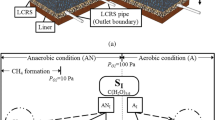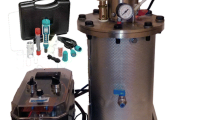Abstract
This study focuses on continuous formaldehyde (FA) biodegradation by Ralstonia eutropha immobilized on polyurethane foam in a semi-pilot-scale plug flow packed-bed bioreactor. The stepwise increasing of the influent FA concentration from 43.9 to 1325.1 mg L−1 was studied in the bioreactor during 70 days of operation. A complete removal of FA was achieved for inlet concentration up to 425.5 mg L−1 and the initial specific biodegradation rate reached to its maximum value about 44.3 mg gcell−1 h−1 at 425.5 mg L−1. However, further increase of inlet concentration resulted in decrease of the biodegradation performance of the immobilized cells due to the inhibitory effect of FA on the enzymatic system involved in the biodegradation process. Based on kinetic modeling results, the Luong equation with the following constants could best describe the behavior of the bio-system: maximum specific FA biodegradation rate (qmax) of 124 mg gcell−1 h−1, half-saturation constant (KS) of 337.2 mg L−1, maximum degradable FA concentration (Smax) of 1582 mg L−1, and shape factor (n) of 1.49. Also, three-dimensional simulation of the bioreactor was performed using an integrated computational fluid dynamics (CFD) approach that takes into account both the biokinetic constants of the immobilized system as well as the fluid properties under steady-state condition. Eulerian computations successfully anticipated the concentration gradients through the reactor for different inlet FA concentrations, and uniform vertical velocity pathlines and non-dispersed plug flow inside the reactor were verified by the presented velocity distribution and flow streamlines.










Similar content being viewed by others
References
Zoutberg GR, de Been P (1997) The Biobeds EGSB (expanded granular sludge bed) system covers shortcomings of the up flow anaerobic sludge blanket reactor in the chemical industry. Water Sci Technol 35:183–188
Oliveira SVWB, Moraes EM, Adorno MAT, Varesche MBA, Foresti E, Zaiat M (2004) Formaldehyde degradation in an anaerobic packed-bed bioreactor. Water Res 38:1685–1694
Edwards FG, Egemen E, Brennan R, Nirmalakhandan N (1999) Ranking of toxic release inventory chemicals using a level III model and toxicity. Water Sci Technol 39:83–90
Kamyabi N, Khan ZS, Vanapalli SA (2017) Flow-induced transport of tumor cells in a microfluidic capillary network: role of friction and repeated deformation. Cell Mol Bioeng 10:563–576
Kamyabi N, Vanapalli SA (2016) Microfluidic cell fragmentation for mechanical phenotyping of cancer cells. Biomicrofluidics 10:021102
Khan ZS, Kamyabi N, Hussain F, Vanapalli SA (2017) Passage times and friction due to flow of confined cancer cells, drops, and deformable particles in a microfluidic channel. Converg Sci Phys Oncol 3:024001
Adroer N, Casas C, de Mas C, Solfi C (1990) Mechanism of formaldehyde biodegradation by Pseudomonas putida. Appl Microbiol Biotechnol 33:217–220
Chongcharoen R, Smith TJ, Flint KP, Dalton H (2005) Adaptation and acclimatization to formaldehyde in methylotrophs capable of high-concentration formaldehyde detoxification. Microbiology 151:2615–2622
Hidlgo A, Lopategi A, Perieto M, Serra JL (2002) Formaldehyde removal in synthetic and industrial waste water by Rhodococcus erythrophis UPV-1. Appl Microbial Biotechnol 58:260–263
Habibi A, Vahabzadeh F (2013) Degradation of formaldehyde at high concentrations by phenol-adapted Ralstonia eutropha closely related to pink-pigmented facultative methylotrophs. J Environ Sci Health 48:279–292
Jiao Z, Luo P, Wu Y, Ding S, Zhang Z (2006) Absorption of lean formaldehyde from air with Na2SO3 solution. J Hazard Mater 134:176–182
Crowther JG, Kosaly G, Lidstrom M (2008) Formate as the branch point for methylotrophic metabolism in Methylobacterium extorquens AM1. J Bacteriol 190:5057–5062
Habibi A, Vahabzadeh F, Zaiat M (2013) Dynamic mathematical models for biodegradation of formaldehyde by Ralstonia eutropha in a batch bioreactor. J Environ Manag 129:548–454
Habibi A, Vahabzadeh F (2013) Formaldehyde degradation in a packed-bed bioreactor using kissiris-immobilized Ralstonia eutropha. Biotech Bioprocess Eng 18:455–464
Raja Priya K, Sandhya S, Swaminathan K (2009) Kinetic analysis of treatment of formaldehyde containing wastewater in UAFB reactor. Chem Eng J 148:212–216
Kourkoutasa Y, Bekatoroua A, Banat IM, Marchant R, Koutinas AA (2004) Immobilization technologies and support materials suitable in alcohol beverages production: a review. Food Microbiol 21:377–397
Jalilnejad E, Vahabzadeh F (2014) Use of a packed-bed airlift reactor with net draft tube to study kinetics of naphthalene degradation by Ralstonia eutropha. Environ Sci Pollut Res 21:4592–4604
Habibi A, Vahabzadeh F (2013) Formaldehyde degradation by Ralstonia eutropha in an immobilized cell bioreactor. J Environ Sci Health 48:1557–1572
Silva AJ, Hirasawa JS, Varesche MB, Foresti E, Zaiat M (2006) Evaluation of support materials for the immobilization of sulfate-reducing bacteria and methanogenic archaea. Anaerobe 12:93–98
Amani A, Jalilnejad E (2017) CFD modeling of formaldehyde biodegradation in an immobilized cell bioreactor with disc-shaped kissiris support. Biochem Eng J 122:47–59
Amani A, Jalilnejad E, Mousavi SM (2018) Simulation of phenol biodegradation by Ralstonia eutropha in a packed-bed bioreactor with batch recycle mode using CFD technique. J Ind Eng Chem 59:310–319
Nash T (1953) The colorimetric estimation of formaldehyde by means of the Hantzsch reaction. Biochem J 55:416–421
American Public Health Association (1998) Standard methods for the examination of water and wastewater, 20th edn. American Water Works Association, and Water Environment Federation, Washington
Crowe C, Sommerfeld M, Tsuji Y (1998) Multiphase flows with droplets and particles. CRC Press, Boca Raton
Van Wachem BGM, Schouten JC, van den Bleek CM, Krishna R, Sinclair JL (2001) Comparative analysis of CFD models of dense gas–solid systems. AIChE J 47:1035–1051
Lu Z, Hegemann W (1998) Anaerobic toxicity and biodegradation of formaldehyde in batch cultures. Water Res 32:209–215
Luong JH (1987) Generalization of Monod kinetics for analysis of growth data with substrate inhibition. Biotechnol Bioeng 29:242–248
Nalband M, Jalilnejad E (2018) Coupled transient CFD-inhibition kinetics modeling of naphthalene biodegradation in an airlift reactor with net draft tube. Polycycl Aromat Compd. https://doi.org/10.1080/10406638.2017.1420668
Muñoz Sierra JD, Picioreanu C, van Loosdrecht MCM (2014) Modeling phototrophic biofilms in a plug-flow reactor. Water Sci Technol 70:1261–1270
Ranganathan P, Savithri S (2018) Computational fluid dynamics simulation of hydrothermal liquefaction of microalgae in a continuous plug-flow reactor. Bioresour Technol 258:151–157
Author information
Authors and Affiliations
Corresponding author
Rights and permissions
About this article
Cite this article
Habibi, A., Nalband, M. & Jalilnejad, E. Experimentation and CFD modeling of continuous degradation of formaldehyde by immobilized Ralstonia eutropha in a semi-pilot-scale plug flow bioreactor. Bioprocess Biosyst Eng 42, 485–497 (2019). https://doi.org/10.1007/s00449-018-2052-7
Received:
Accepted:
Published:
Issue Date:
DOI: https://doi.org/10.1007/s00449-018-2052-7




